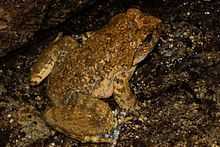Quasipaa spinosa
| Quasipaa spinosa | |
|---|---|
 | |
| Conservation status | |
| Scientific classification | |
| Kingdom: | Animalia |
| Phylum: | Chordata |
| Class: | "Amphibia" (wide sense) |
| Order: | Anura |
| Family: | Dicroglossidae |
| Genus: | Quasipaa |
| Species: | Q. spinosa |
| Binomial name | |
| Quasipaa spinosa (David, 1875) | |
| Synonyms | |
|
Rana latrans David, 1872 | |
Quasipaa spinosa is a species of frog in the family Dicroglossidae. It is known under many common names, including Chinese spiny frog, giant spiny frog, Chinese edible frog, and spiny paa frog.[2] Its names refer to the distinctive characteristics of the species, relatively large size and the spiny chest of male frogs.[3][4] Giant in frog terms only, it can nevertheless grow to lengths above 10 cm (4 in); this makes it the largest frog in Hong Kong.[3][5]
Taxonomy
Recent molecular phylogenetic analyses have suggested that Quasipaa spinosa is split in three distinct lineages; the nominal Quasipaa spinosa may thus represent a cryptic species complex. The lineages are geographically distinct; one lineage is found in Yunnan, another one in southeastern China (Anhui, Zhejiang, northern Fujian, and Jiangxi), and the third one in south-central China (southern Fujian, Jiangxi, Hunan, Guangdong, and Guangxi). In this analysis, Quasipaa exilispinosa is nested within Quasipaa spinosa.[6]
The complete mitochondrial genome (18,012 base pairs in length) of Quasipaa spinosa has been sequenced, helping to shed light into the phylogeny of Quasipaa and related frogs.[7]
Distribution
It is found in China south of the Yangtze River, including Hong Kong. It is expected to be found in Vietnam, Laos, and Myanmar. No certain records exist from Vietnam, earlier records may refer to Quasipaa acanthophora described in 2009 as a new species from that country.[2] It may also have been mixed with Quasipaa verrucospinosa and Nanorana yunnanensis.[1]
Description
The most distinctive characteristic of Quasipaa spinosa are the keratinized skin spines in the chest of males.[8][4] It is dark brown in colour, interspersed with dense, yellowish mottling.[3]
Quasipaa spinosa are moderately large frogs: males grow to a snout–vent length of about 80 mm (3.1 in) and females to 82 mm (3.2 in)[9] or more, up to 128 mm (5.0 in) in snout–vent length.[10][3] It is the largest frog in Hong Kong.[3][5] Later studies has shown that usually males are larger than females, but with considerable overlap between sexes. Body size is positively correlated with maximum temperature and rainfall. Mean body weight among males may reach at least 133 g (4.7 oz).[4]
Reproduction takes place in April–October. Male frogs call near slow-flowing sections of streams or around pools adjacent to streams. The advertisement call consists of three to seven notes, the last being the longest. Pairs in amplexus are found within the chorus area.[11]
_%E6%A3%98%E8%83%B8%E8%9B%992.jpg)
Habitat
Quasipaa spinosa is associated with rocky streams in evergreen forests and open countryside on hills and mountains. Its altitude range is about 200–1,500 m (660–4,920 ft) above sea level. It breeds in streams, laying the eggs in water under stones.[1]
Conservation
This species is believed to have declined dramatically in abundance. It is classified as "Vulnerable" by the International Union for Conservation of Nature because the decline is estimated to be more than 30% over the last three generations. The main reasons for the decline is (over)collection for human consumption, and it is also threatened by habitat loss caused by agriculture and dam construction.[1]
References
- ↑ 1.0 1.1 1.2 1.3 Lau, M.W.N., Gu Huiqing, Geng Baorong, van Dijk, P.P. & Bain. R. (2004). "Quasipaa spinosa". IUCN Red List of Threatened Species. Version 2013.1. International Union for Conservation of Nature. Retrieved 15 December 2013.
- ↑ 2.0 2.1 Frost, Darrel R. (2013). "Quasipaa spinosa (David, 1875)". Amphibian Species of the World 5.6, an Online Reference. American Museum of Natural History. Retrieved 15 December 2013.
- ↑ 3.0 3.1 3.2 3.3 3.4 Tony, Hung Tun Hei (2006–2011). "Giant Spiny Frog". Programmes of Ecology & Biodiversity, Hong Kong University. Retrieved 18 December 2013.
- ↑ 4.0 4.1 4.2 Yu, B. G.; Zheng, R. Q.; Zhang, Y.; Liu, C. T. (2010). "Geographic variation in body size and sexual size dimorphism in the giant spiny frog Paa spinosa (David, 1875) (Anura: Ranoidae)". Journal of Natural History 44 (27–28): 1729. doi:10.1080/00222931003632682.
- ↑ 5.0 5.1 Agriculture, Fisheries and Conservation Department (2006). "Amphibians of Hong Kong". HK SPecies. The Government of Hong Kong SAR. Retrieved 18 December 2013.
- ↑ Ye, S.; Huang, H.; Zheng, R.; Zhang, J.; Yang, G.; Xu, S. (2013). "Phylogeographic analyses strongly suggest cryptic speciation in the giant spiny frog (Dicroglossidae: Paa spinosa) and interspecies hybridization in Paa". In Fenton, Brock. PLoS ONE 8 (7): e70403. doi:10.1371/journal.pone.0070403. PMC 3729840. PMID 23936199.
- ↑ Zhou, Y.; Zhang, J. Y.; Zheng, R. Q.; Yu, B. G.; Yang, G. (2009). "Complete nucleotide sequence and gene organization of the mitochondrial genome of Paa spinosa (Anura: Ranoidae)". Gene 447 (2): 86–96. doi:10.1016/j.gene.2009.07.009. PMID 19631263.
- ↑ Zheng, R. Q.; Ye, R.; Yu, Y.; Yang, G. (2009). "Fifteen polymorphic microsatellite markers for the giant spiny frog, Paa spinosa". Molecular Ecology Resources 9 (1): 336–338. doi:10.1111/j.1755-0998.2008.02420.x. PMID 21564643.
- ↑ Fei, L. (1999). Atlas of Amphibians of China (in Chinese). Zhengzhou: Henan Press of Science and Technology. p. 208–210. ISBN 7-5349-1835-9.
- ↑ Zheng, R. Q.; Liu, C. T. (2010). "Giant spiny-frog (Paa spinosa) from different populations differ in thermal preference but not in thermal tolerance". Aquatic Ecology 44 (4): 723. doi:10.1007/s10452-009-9310-3.
- ↑ Yu, Baogen; Zheng, Rongquan (2009). "The advertisement call of the giant spiny frog Paa spinosa". Current Zoology 55 (6): 411–415.
